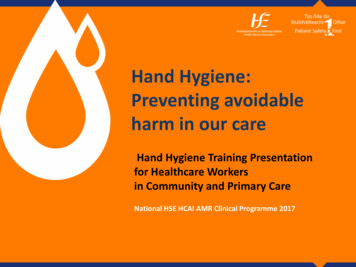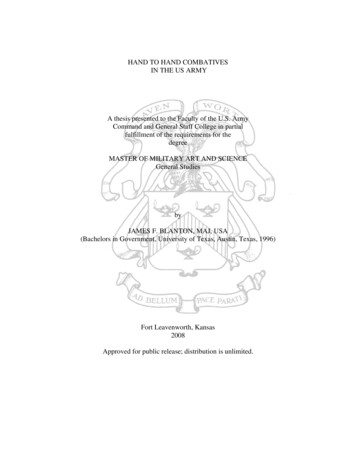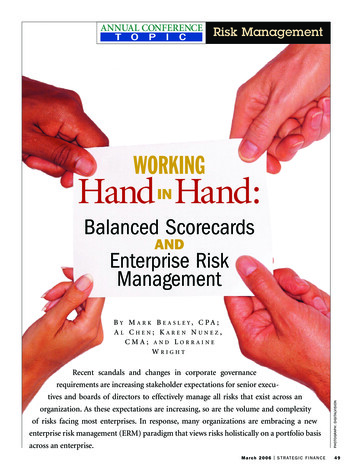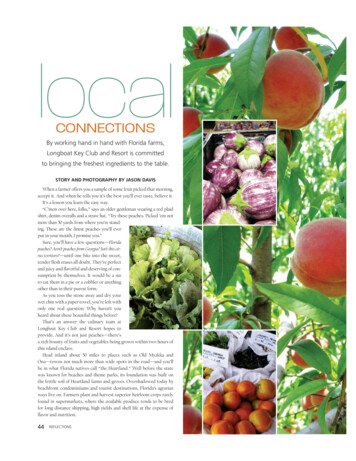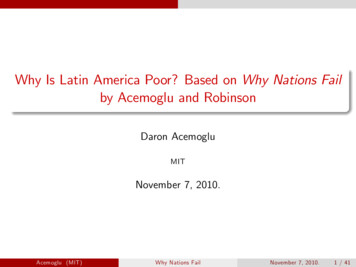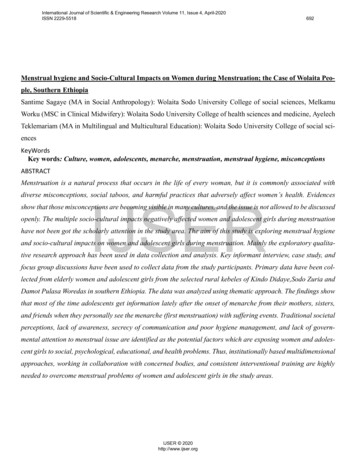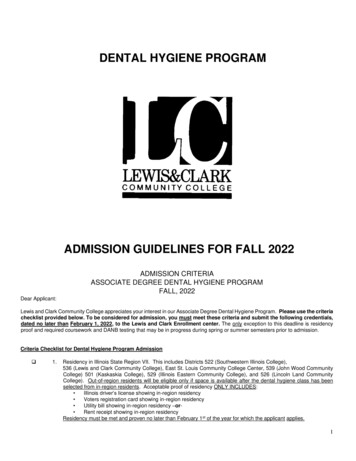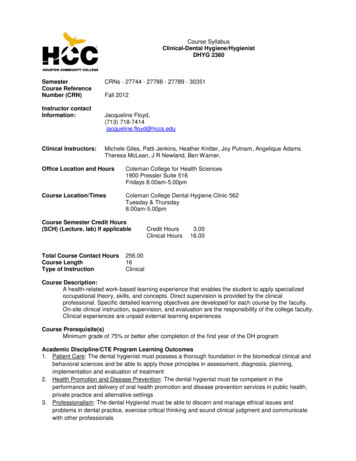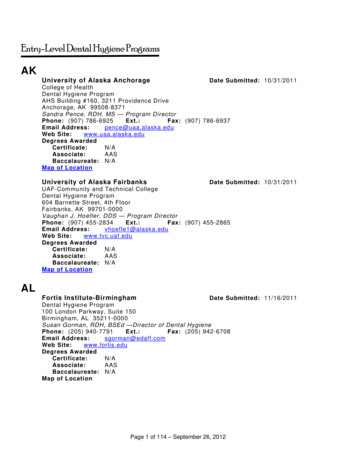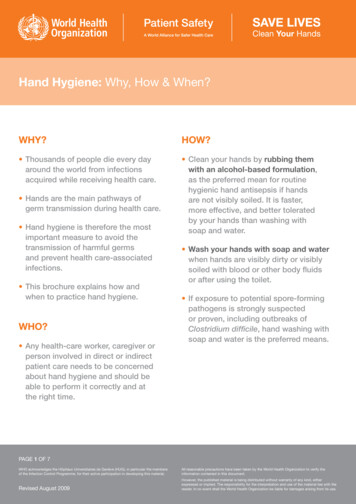
Transcription
Hand Hygiene: Why, How & When?WHY?HOW? Thousands of people die every dayaround the world from infectionsacquired while receiving health care. Clean your hands by rubbing themwith an alcohol-based formulation,as the preferred mean for routinehygienic hand antisepsis if handsare not visibly soiled. It is faster,more effective, and better toleratedby your hands than washing withsoap and water. Hands are the main pathways ofgerm transmission during health care. Hand hygiene is therefore the mostimportant measure to avoid thetransmission of harmful germsand prevent health care-associatedinfections. This brochure explains how andwhen to practice hand hygiene.WHO? Any health-care worker, caregiver orperson involved in direct or indirectpatient care needs to be concernedabout hand hygiene and should beable to perform it correctly and atthe right time. Wash your hands with soap and waterwhen hands are visibly dirty or visiblysoiled with blood or other body fluidsor after using the toilet. If exposure to potential spore-formingpathogens is strongly suspectedor proven, including outbreaks ofClostridium difficile, hand washing withsoap and water is the preferred means.PAGE 1 OF 7WHO acknowledges the Hôpitaux Universitaires de Genève (HUG), in particular the membersof the Infection Control Programme, for their active participation in developing this material.All reasonable precautions have been taken by the World Health Organization to verify theinformation contained in this document.Revised August 2009However, the published material is being distributed without warranty of any kind, eitherexpressed or implied. The responsibility for the interpretation and use of the material lies with thereader. In no event shall the World Health Organization be liable for damages arising from its use.
HAND HYGIENE: WHY, HOW & WHEN?HOW TO HANDRUB?RUB HANDS FOR HAND HYGIENE! WASH HANDS WHEN VISIBLY SOILEDDuration of the entire procedure: 20-30 seconds1a1b2Apply a palmful of the product in a cupped hand, covering all surfaces;3Right palm over left dorsum withinterlaced fingers and vice versa;6Rotational rubbing of left thumbclasped in right palm and vice versa;Rub hands palm to palm;45Palm to palm with fingers interlaced;7Backs of fingers to opposing palmswith fingers interlocked;8Rotational rubbing, backwards andforwards with clasped fingers of righthand in left palm and vice versa;Once dry, your hands are safe.PAGE 2 OF 7WHO acknowledges the Hôpitaux Universitaires de Genève (HUG), in particular the membersof the Infection Control Programme, for their active participation in developing this material.All reasonable precautions have been taken by the World Health Organization to verify theinformation contained in this document.However, the published material is being distributed without warranty of any kind, eitherexpressed or implied. The responsibility for the interpretation and use of the material lies with thereader. In no event shall the World Health Organization be liable for damages arising from its use.
HAND HYGIENE: WHY, HOW & WHEN?HOW TO HANDWASH?WASH HANDS WHEN VISIBLY SOILED! OTHERWISE, USE HANDRUBDuration of the entire procedure: 40-60 seconds0Wet hands with water;1Apply enough soap to coverall hand surfaces;3Right palm over left dorsum withinterlaced fingers and vice versa;9Dry hands thoroughlywith a single use towel;Rub hands palm to palm;45Palm to palm with fingers interlaced;6Rotational rubbing of left thumbclasped in right palm and vice versa;27Backs of fingers to opposing palmswith fingers interlocked;8Rotational rubbing, backwards andforwards with clasped fingers of righthand in left palm and vice versa;Rinse hands with water;1011Use towel to turn off faucet;Your hands are now safe.Hand carePlease remember Take care of your hands by regularly using a protectivehand cream or lotion, at least daily. Do not wear artificial fingernailsor extenders when in directcontact with patients. Do not routinely wash hands with soap and water immediatelybefore or after using an alcohol-based handrub. Keep natural nails short. Do not use hot water to rinse your hands. After handrubbing or handwashing, let your handsdry completely before putting on gloves.PAGE 3 OF 7WHO acknowledges the Hôpitaux Universitaires de Genève (HUG), in particular the membersof the Infection Control Programme, for their active participation in developing this material.All reasonable precautions have been taken by the World Health Organization to verify theinformation contained in this document.However, the published material is being distributed without warranty of any kind, eitherexpressed or implied. The responsibility for the interpretation and use of the material lies with thereader. In no event shall the World Health Organization be liable for damages arising from its use.
HAND HYGIENE: WHY, HOW & WHEN?WHEN?YOUR 5 MOMENTSFOR HAND HYGIENE*EOR /ASEPFTICE EANL OCEDUREC R2PBCRITICAL SITE WITHINFECTIOUS RISKFOR THE PATIENT4YE3DAFT E R BO UFLUOSPIDXERISKR1BEFORETOUCHINGA PATIENTAFTERTOUCHINGA PATIENTCRITICAL SITEWITH BODY FLUIDEXPOSURE RISK5AFTERTOUCHING PATIENTSURROUNDINGS*NOTE: Hand hygiene must be performed in all indicationsdescribed regardless of whether gloves are used or not.PAGE 4 OF 7WHO acknowledges the Hôpitaux Universitaires de Genève (HUG), in particular the membersof the Infection Control Programme, for their active participation in developing this material.All reasonable precautions have been taken by the World Health Organization to verify theinformation contained in this document.However, the published material is being distributed without warranty of any kind, eitherexpressed or implied. The responsibility for the interpretation and use of the material lies with thereader. In no event shall the World Health Organization be liable for damages arising from its use.
HAND HYGIENE: WHY, HOW & WHEN?14Before touching a patientAfter touching a patientWHY? To protect the patient against colonization and, in some cases,against exogenous infection, by harmful germs carried on your handsWHY? To protect you from colonization with patient germsand to protect the health-care environment from germ spreadWHEN? Clean your hands before touching a patient whenapproaching him/her*WHEN? Clean your hands when leaving the patient’s side,after having touched the patient *Situations when Moment 1 applies:a) Before shaking hands, before stroking a child’s foreheadb) Before assisting a patient in personal care activities:to move, to take a bath, to eat, to get dressed, etcc) Before delivering care and other non-invasive treatment:applying oxygen mask, giving a massagec) Before performing a physical non-invasive examination:taking pulse, blood pressure, chest auscultation, recording ECG2Before clean / aseptic procedureWHY? To protect the patient against infection with harmful germs,including his/her own germs, entering his/her bodyWHEN? Clean your hands immediately before accessing a criticalsite with infectious risk for the patient (e.g. a mucous membrane,non-intact skin, an invasive medical device)*Situations when Moment 4 applies, if they correspond to thelast contact with the patient before leaving him / her:a) After shaking hands, stroking a child’s foreheadb) After you have assisted the patient in personal care activities:to move, to bath, to eat, to dress, etcc) After delivering care and other non-invasive treatment: changing bedlinen as the patient is in, applying oxygen mask, giving a massaged) After performing a physical non-invasive examination:taking pulse, blood pressure, chest auscultation, recording ECG5After touching patient surroundingsWHY? To protect you from colonization with patient germs that maybe present on surfaces / objects in patient surroundings and to protectthe health-care environment against germ spreadWHEN? Clean your hands after touching any object or furniture whenliving the patient surroundings, without having touched the patient*Situations when Moment 2 applies:a) Before brushing the patient’s teeth, instilling eye drops, performing a digitalvaginal or rectal examination, examining mouth, nose, ear with or withoutan instrument, inserting a suppository / pessary, suctioning mucousb) Before dressing a wound with or without instrument, applying ointmenton vesicle, making a percutaneous injection / puncturec) Before inserting an invasive medical device (nasal cannula, nasogastrictube, endotracheal tube, urinary probe, percutaneous catheter, drainage),disrupting / opening any circuit of an invasive medical device (for food,medication, draining, suctioning, monitoring purposes)d) Before preparing food, medications, pharmaceutical products,sterile materialThis Moment 5 applies in the following situations if they correspondto the last contact with the patient surroundings, without havingtouched the patient:a) After an activity involving physical contact with the patients immediateenvironment: changing bed linen with the patient out of the bed,holding a bed trail, clearing a bedside tableb) After a care activity: adjusting perfusion speed, clearing a monitoring alarmc) After other contacts with surfaces or inanimate objects (note – ideallytry to avoid these unnecessary activities): leaning against a bed,leaning against a night table / bedside table3After body fluid exposure riskWHY? To protect you from colonization or infection withpatient’s harmful germs and to protect the health-careenvironment from germ spreadWHEN? Clean your hands as soon as the task involving anexposure risk to body fluids has ended (and after glove removal)*Situations when Moment 3 applies:a) When the contact with a mucous membrane and with non-intact skin endsb) After a percutaneous injection or puncture; after inserting an invasivemedical device (vascular access, catheter, tube, drain, etc); afterdisrupting and opening an invasive circuitc) After removing an invasive medical deviced) After removing any form of material offering protection(napkin, dressing, gauze, sanitary towel, etc)e) After handling a sample containing organic matter, after clearingexcreta and any other body fluid, after cleaning any contaminatedsurface and soiled material (soiled bed linen, dentures, instruments,urinal, bedpan, lavatories, etc)*NOTE: Hand hygiene must be performed in all indicationsdescribed regardless of whether gloves are used or not.PAGE 5 OF 7WHO acknowledges the Hôpitaux Universitaires de Genève (HUG), in particular the membersof the Infection Control Programme, for their active participation in developing this material.All reasonable precautions have been taken by the World Health Organization to verify theinformation contained in this document.However, the published material is being distributed without warranty of any kind, eitherexpressed or implied. The responsibility for the interpretation and use of the material lies with thereader. In no event shall the World Health Organization be liable for damages arising from its use.
HAND HYGIENE: WHY, HOW & WHEN?HAND HYGIENE AND MEDICAL GLOVE USEThe Glove Pyramid – to aid decision makingon when to wear (and not wear) gloves The use of gloves does not replace the need for cleaningyour hands.Gloves must be worn according to STANDARD and CONTACTPRECAUTIONS. The pyramid details some clinical examples in whichgloves are not indicated, and others in which clean or sterile gloves areindicated. Hand hygiene should be performed when appropriateregardless of indications for glove use. Hand hygiene must be performed when appropriate regardlessof the indications for glove use. Remove gloves to perform hand hygiene, when an indicationoccurs while wearing gloves. Discard gloves after each task and clean your hands –gloves may carry germs. Wear gloves only when indicated according to Standard andContact Precautions (see examples in the pyramid below) –otherwise they become a major risk for germ transmission.STERILEGLOVESINDICATEDAny surgical procedure;vaginal delivery; invasiveradiological procedures;performing vascular accessand procedures (central lines);preparing total parental nutritionand chemotherapeutic agents.EXAMINATION GLOVESINDICATED IN CLINICAL SITUATIONSPotential for touching blood, body fluids, secretions,excretions and items visibly soiled by body fluids.DIRECT PATIENT EXPOSURE: Contact with blood; contact withmucous membrane and with non-intact skin; potential presence ofhighly infectious and dangerous organism; epidemic or emergencysituations; IV insertion and removal; drawing blood; discontinuationof venous line; pelvic and vaginal examination; suctioning non-closedsystems of endotrcheal tubes.INDIRECT PATIENT EXPOSURE: Emptying emesis basins; handling/cleaninginstruments; handling waste; cleaning up spills of body fluids.GLOVES NOT INDICATED (except for CONTACT precautions)No potential for exposure to blood or body fluids, or contaminated environmentDIRECT PATIENT EXPOSURE: Taking blood pressure, temperature and pulse; performing SCand IM injections; bathing and dressing the patient; transporting patient; caring for eyes and ears(without secretions); any vascular line manipulation in absence of blood leakage.INDIRECT PATIENT EXPOSURE: Using the telephone; writing in the patient chart; giving oral medications;distributing or collecting patinet dietary trays; removing and replacing linen for patient bed; placing non-invasiveventilation equipment and oxygen cannula; moving patient furniture.PAGE 6 OF 7WHO acknowledges the Hôpitaux Universitaires de Genève (HUG), in particular the membersof the Infection Control Programme, for their active participation in developing this material.All reasonable precautions have been taken by the World Health Organization to verify theinformation contained in this document.However, the published material is being distributed without warranty of any kind, eitherexpressed or implied. The responsibility for the interpretation and use of the material lies with thereader. In no event s
Hands are the main pathways of germ transmission during health care. Hand hygiene is therefore the most important measure to avoid the transmission of harmful germs and prevent health care-associated infections. This brochure explains how and when to practice hand hygiene. WHO? Any health-care worker, caregiver or person involved in direct or indirect patient care needs to be .
